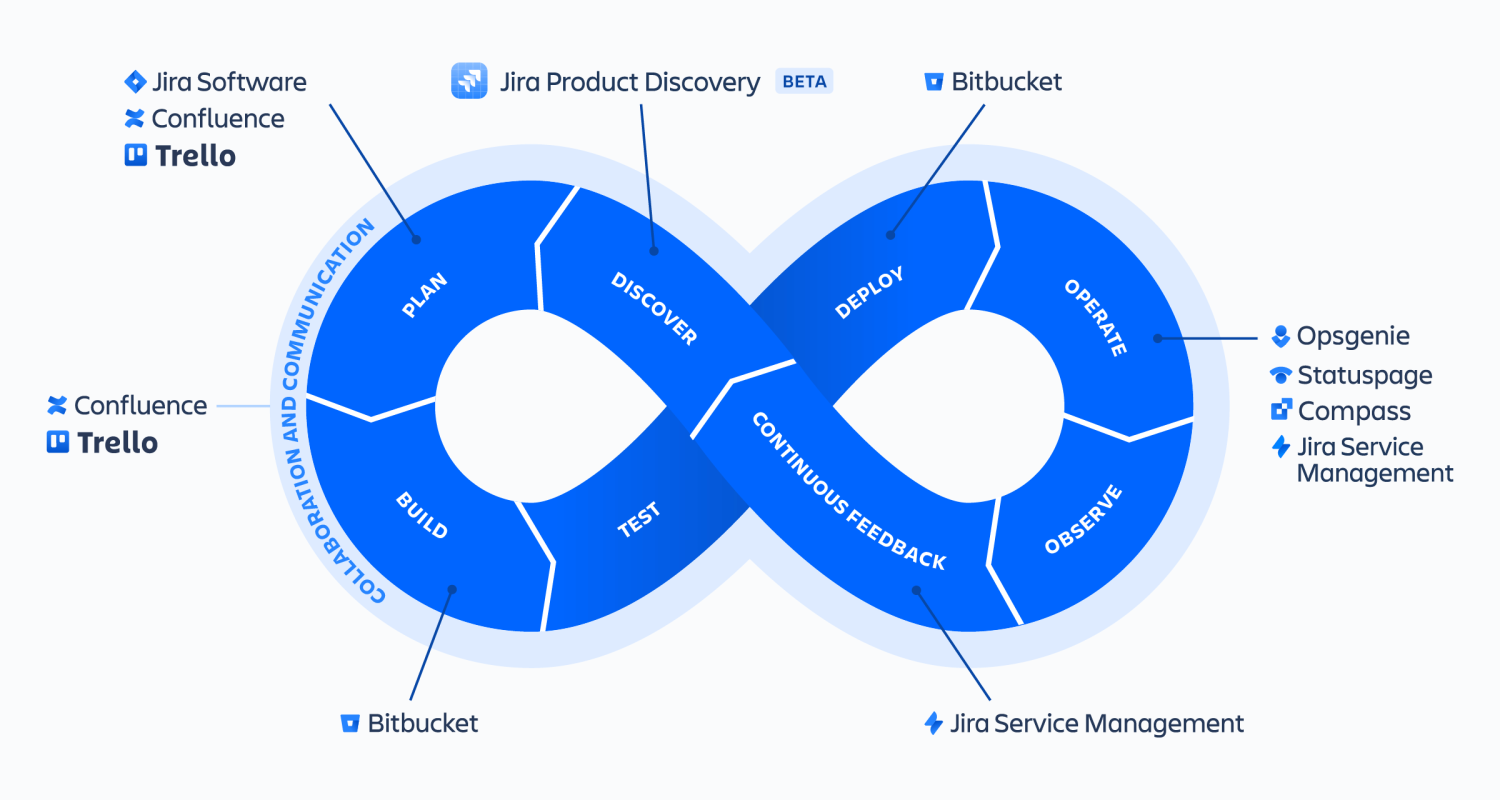
In today’s fast-paced IT landscape, streamlining operations is key to maintaining agility, efficiency, and quality. DevOps offers a range of best practices to help organizations enhance their IT operations. Below are some essential DevOps strategies to optimize your processes:
1. Embrace Continuous Integration and Continuous Delivery (CI/CD)
Continuous Integration (CI) and Continuous Delivery (CD) form the backbone of DevOps. By automating code integration and deploying it in small, incremental updates, organizations reduce the risk of errors and ensure faster, more reliable releases. CI/CD pipelines streamline IT operations by accelerating development cycles while maintaining high standards of quality.
2. Adopt Agile Methodologies
Agile principles prioritize flexibility, collaboration, and iterative progress, making them a natural fit with DevOps. By integrating Agile practices, teams can respond more quickly to changes, increase collaboration, and align closely with customer needs, all while improving the overall IT workflow.
3. Automation in DevOps
Automation is fundamental in DevOps. From automating builds and tests to deploying infrastructure, automation reduces manual errors, speeds up delivery processes, and frees up your IT team to focus on more strategic tasks. Tools such as Jenkins, GitLab, and Ansible are widely used to automate repetitive processes across the DevOps lifecycle.
4. Utilize Collaboration Tools
Effective communication is essential for DevOps success. Collaboration tools such as Slack, Jira, and Microsoft Teams can improve communication between development, operations, and security teams. This enhanced collaboration fosters transparency and ensures that all stakeholders are aligned on objectives and tasks.
5. Leverage Infrastructure as Code (IaC)
Managing infrastructure through code, often known as Infrastructure as Code (IaC), allows for consistency and scalability in deploying and managing resources. Tools like Terraform and AWS CloudFormation enable teams to define, provision, and update infrastructure programmatically, which simplifies the setup of environments, eliminates configuration drift, and ensures reproducibility.
6. Implement Robust Monitoring and Logging
Real-time monitoring and comprehensive logging are essential for proactive IT operations. Tools like Prometheus, Grafana, and ELK stack (Elasticsearch, Logstash, Kibana) enable teams to monitor systems, identify issues, and resolve them before they impact the end user. Logging and monitoring provide visibility into your systems, allowing for continuous performance optimization.
7. Ensure Strong Version Control
Version control systems like Git are vital for tracking changes, maintaining code history, and ensuring collaboration among developers. Having a clear version control process ensures that teams can easily manage multiple iterations of code, reducing conflicts and ensuring consistency across different environments.
8. Integrate DevSecOps
Security should be integrated throughout the DevOps lifecycle, not as an afterthought. DevSecOps incorporates security practices into the development pipeline, ensuring that security vulnerabilities are identified and addressed early in the process. Automated security testing, code reviews, and compliance checks are essential components of DevSecOps.
9. Optimize Deployment Strategies
Deployment strategies such as Blue-Green Deployments, Canary Releases, and Rolling Deployments help to minimize downtime and reduce the risk of deployment failure. By gradually releasing new versions of your application or service, teams can monitor for issues and revert to a previous version if necessary, ensuring a smoother and safer rollout.
10. Focus on Performance Optimization
Continuously optimizing performance is a key factor in DevOps. Monitoring load times, improving system efficiency, and reducing bottlenecks help to ensure that applications run smoothly. Performance optimization can be achieved by fine-tuning configurations, scaling infrastructure, and optimizing code.
11. Adopt Cloud DevOps
Cloud platforms like AWS, Azure, and Google Cloud offer a range of services tailored for DevOps practices. Cloud DevOps allows teams to leverage the scalability, flexibility, and automation capabilities of cloud services, enabling faster development cycles and more efficient IT operations.
12. Foster Team Collaboration

Finally, effective DevOps relies on cross-functional team collaboration. Bringing together development, operations, and security teams under a common set of goals ensures that everyone is working towards the same objectives. Collaboration helps to identify and address potential bottlenecks, creating a more streamlined and unified workflow.
13. Leverage Microservices Architecture
Transitioning from monolithic architectures to microservices enables teams to build applications as a collection of loosely coupled services. Each service can be independently developed, deployed, and scaled, allowing teams to work more efficiently. With microservices, failures in one service do not affect the entire application, leading to higher availability and simplified scaling. This approach also aligns well with DevOps’ focus on agility and faster releases.
14. Emphasize on Continuous Feedback Loops
Continuous feedback ensures that teams receive real-time insights from both customers and internal stakeholders. By incorporating customer feedback into the development process, teams can prioritize features, improve user experience, and quickly address issues. Regular feedback loops between development and operations teams also help in identifying performance bottlenecks and areas for improvement, fostering a culture of constant enhancement.
15. Encourage a Culture of Continuous Learning
DevOps is not just a methodology—it’s a mindset. For successful implementation, organizations should encourage continuous learning and upskilling. Providing training on new tools, methodologies, and security practices helps teams stay updated with industry trends and enables them to adapt quickly to changes. Hosting regular knowledge-sharing sessions and workshops fosters a learning culture that keeps the team agile and innovative.
16. Adopt Scalable Cloud Infrastructure
Cloud-native DevOps practices enable scalability and flexibility. By using cloud infrastructure, IT teams can easily scale their resources up or down depending on demand. This agility ensures cost efficiency, as resources are only utilized as needed. Cloud providers also offer built-in tools for monitoring, logging, and security, which can further streamline operations. Combining cloud with DevOps allows teams to achieve faster provisioning, automated scaling, and seamless integration with continuous delivery pipelines.
17. Prioritize Disaster Recovery and Business Continuity
Ensuring business continuity in the face of unexpected incidents is a crucial aspect of IT operations. DevOps practices should include automated backup strategies, regular disaster recovery drills, and failover mechanisms. By incorporating redundancy and fail-safes into the infrastructure, teams can reduce downtime and mitigate the risk of data loss. This ensures that the organization can maintain high availability and resilience, even in the event of system failures or cyberattacks.
18. Establish Clear Metrics and KPIs
To measure the effectiveness of DevOps practices, organizations need clear Key Performance Indicators (KPIs) and metrics. Common metrics include deployment frequency, lead time for changes, mean time to recovery (MTTR), and change failure rate. These metrics provide valuable insights into the performance and efficiency of IT operations, helping teams identify areas that need improvement and optimizing their processes for better outcomes.
19. Drive Innovation Through Experimentation
Encourage teams to experiment with new tools, technologies, and methodologies. DevOps thrives on innovation, and creating an environment where teams can try new approaches can lead to breakthrough improvements in IT operations. Whether it’s adopting new automation tools, integrating AI-driven monitoring systems, or implementing containerization through Docker and Kubernetes, experimentation fosters growth and allows teams to discover more efficient ways of working.
20. Integrate Testing into Every Stage
In traditional development models, testing often occurs towards the end of the software development lifecycle. However, in DevOps, testing should be integrated into every stage of the process. Automated tests—such as unit tests, integration tests, and security scans—ensure that code is verified continuously. This helps catch issues early, reduces deployment risks, and maintains the quality of the final product.
21. Foster Cross-Departmental Ownership and Accountability
One of the core principles of DevOps is fostering a culture of shared responsibility. In traditional IT environments, the development and operations teams often work in silos, which can lead to misunderstandings and delayed issue resolution. By encouraging cross-departmental ownership, where both development and operations teams take joint responsibility for the performance and stability of the product, organizations can significantly reduce downtime and enhance collaboration.
Shared accountability also ensures that the development team remains mindful of operational requirements such as performance, reliability, and scalability, while the operations team stays informed about new features and potential deployment risks. This holistic view enables faster problem-solving and a smoother workflow.
22. Focus on DevOps Security: Shift Left Approach
Security is a critical element in today’s DevOps ecosystem, and the “Shift Left” approach emphasizes integrating security early in the development process. Rather than leaving security as the last step before deployment, incorporating DevSecOps principles ensures that security checks, vulnerability scans, and compliance audits are part of the continuous integration pipeline.
Automated security testing can detect potential vulnerabilities as soon as new code is pushed, preventing costly fixes later in the development lifecycle. Moreover, by educating the development team on secure coding practices, organizations can reduce the risk of vulnerabilities slipping through.
23. Optimize Cloud Cost Management
As organizations move their IT operations to the cloud, managing cloud costs becomes a significant priority. Cloud-native DevOps teams can utilize tools like AWS Cost Explorer or Azure Cost Management to track and optimize resource utilization. Automation scripts can be set up to scale resources dynamically based on usage, ensuring that your infrastructure remains cost-efficient.
Regular cloud usage reviews can identify idle resources, over-provisioned instances, and opportunities for savings through reserved instances or spot pricing. By optimizing cloud costs, businesses can increase profitability while maintaining scalability.
24. Utilize Containers and Kubernetes for Efficient Scalability
Containers, powered by technologies like Docker, offer an efficient way to run applications consistently across different environments. Containers package the code, dependencies, and configurations needed to run a service, ensuring a lightweight, portable solution that enhances scalability.
For even greater efficiency, orchestration platforms like Kubernetes enable automated deployment, scaling, and management of containerized applications. Kubernetes allows for fine-tuned control over resource allocation, making it easier to manage multiple services while optimizing resource usage. By adopting containerization and orchestration, IT operations teams can streamline deployments and maintain high availability, even during peak loads.
25. Streamline Configuration Management with Tools
Configuration management tools like Ansible, Puppet, and Chef are essential for maintaining consistency across environments. By defining and automating the configuration of servers, networks, and applications, these tools help eliminate configuration drift and ensure that all systems remain aligned with desired settings.
Automating configuration management also reduces human error, speeds up provisioning, and makes it easier to deploy updates or patches across large-scale infrastructures. When combined with Infrastructure as Code (IaC) practices, these tools enable dynamic, scalable, and efficient management of IT resources.
26. Leverage Artificial Intelligence and Machine Learning in DevOps
AI and Machine Learning (ML) are increasingly being integrated into DevOps workflows to improve automation, predictive analytics, and decision-making. AI-powered monitoring tools can identify patterns and anomalies in system performance, automatically triggering alerts or scaling actions to prevent downtime.
Machine Learning algorithms can also optimize continuous integration and delivery pipelines by predicting deployment failures or identifying inefficiencies in the development process. By leveraging AI and ML, organizations can make data-driven decisions and proactively optimize their IT operations for better performance and reliability.
27. Adopt a Culture of Continuous Improvement (Kaizen)
Continuous improvement, or Kaizen, is a central principle in DevOps. By consistently evaluating workflows, identifying bottlenecks, and seeking out opportunities for optimization, teams can continually improve their processes. Regular retrospectives, feedback sessions, and performance reviews enable teams to reflect on past challenges and refine their approach moving forward.
Encouraging a mindset of ongoing refinement ensures that the DevOps culture stays adaptive to changes in technology, customer needs, and business objectives. By applying the Kaizen philosophy, IT operations remain agile and resilient in the face of evolving demands.
Conclusion: The Future of DevOps in IT Operations
As we move further into the digital age, the role of DevOps in IT operations will only continue to grow. Organizations that embrace DevOps best practices not only improve their efficiency but also foster a culture of innovation and collaboration that is essential for long-term success. The ability to adapt quickly to market changes, streamline operations, and continuously improve product quality will give businesses a competitive edge.
Key technologies such as AI, machine learning, and cloud computing are transforming DevOps, bringing more automation and intelligence to the process. The integration of these technologies into DevOps workflows will enable teams to be more proactive, making data-driven decisions that enhance performance, security, and scalability.
Moreover, the expansion of DevSecOps and the focus on security throughout the development lifecycle will ensure that IT operations remain secure and compliant, even as the threat landscape evolves.
Final Takeaways:
- Automation is at the heart of DevOps. Streamlining repetitive tasks through tools and scripts reduces human error and speeds up deployment.
- Continuous Integration and Delivery (CI/CD) pipelines ensure that code is frequently tested, integrated, and delivered with minimal downtime.
- Agile Methodologies drive fast, iterative development, fostering collaboration and ensuring that teams can adapt quickly to changing requirements.
- Infrastructure as Code (IaC) and Configuration Management tools provide consistency and scalability across different environments.
- Security is now a key element of DevOps, with a focus on integrating security testing and monitoring early in the development process.
- Cloud DevOps enables organizations to scale their IT resources dynamically, ensuring high availability and cost efficiency.
- AI and Machine Learning are bringing intelligent insights and predictive analytics to DevOps, enhancing performance and automating decision-making processes.
- Collaboration between teams is essential, ensuring that development, operations, and security teams work together to deliver high-quality, secure applications.
By continuously evolving and adopting new practices, DevOps will remain the driving force behind modern IT operations, enabling businesses to scale, innovate, and thrive in an increasingly competitive and fast-paced digital world.
Written By – Seema Kanojiya







